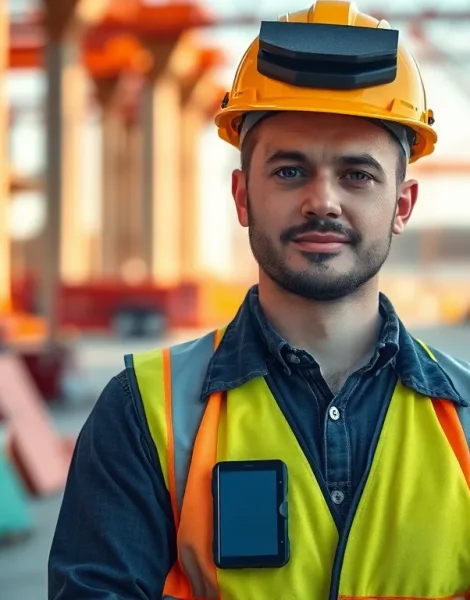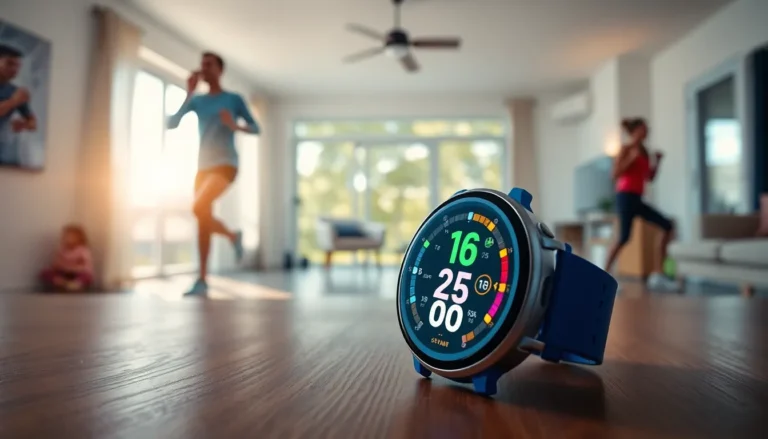In today’s fast-paced work environment, staying safe often feels like a game of dodgeball—except the balls are heavy machinery and the stakes are a lot higher. Enter workplace safety wearables, the unsung heroes of the modern job site. These nifty gadgets not only keep employees safe but also add a dash of tech-savvy flair to their daily grind.
Imagine your team sporting smart helmets that beep like an overzealous GPS when they stray too close to danger. It’s like having a personal safety coach that’s always on the clock. With wearables tracking everything from heart rates to location, companies can finally say goodbye to the “I didn’t see that coming” excuse. Embracing these innovations isn’t just smart; it’s essential for creating a culture where safety and productivity go hand in hand—without sacrificing a sense of humor along the way.
Table of Contents
ToggleOverview of Workplace Safety Wearables
Workplace safety wearables represent a crucial advancement in employee protection and risk mitigation. These devices combine technology and practicality, aiming to enhance safety in various work environments.
Definition and Purpose
Workplace safety wearables consist of devices designed to monitor workers’ health and safety conditions. These gadgets track critical metrics such as heart rates, locations, and environmental hazards. By providing immediate alerts, wearables help prevent accidents and foster a safety-first culture. Implementing these technologies reduces workplace injuries and promotes employee well-being. As companies prioritize safety, wearables become essential tools for maintaining productivity and compliance.
Types of Wearables
Various types of workplace safety wearables are available, each serving unique purposes. Smart helmets enhance visibility and provide augmented reality features. Wearable sensors can monitor physical exertion and fatigue levels. Smart vests can detect falls and alert supervisors in real-time. GPS-enabled devices track worker locations in hazardous areas. Finally, smart badges help manage access control and monitor environmental conditions. The diversity in wearables ensures that companies can choose solutions tailored to their specific safety needs.
Benefits of Workplace Safety Wearables

Workplace safety wearables significantly boost employee safety and health monitoring in various environments. Smart technology plays a crucial role in minimizing risks on the job site.
Enhancing Employee Safety
Wearables like smart helmets provide real-time alerts about hazardous conditions. Monitoring vital signs helps identify potential health issues before they escalate. Wearable sensors track movements and alert employees to unsafe behaviors, reducing the likelihood of accidents. Smart vests incorporate alerts for environmental hazards, ensuring workers remain aware of their surroundings. Employees wearing these devices feel safer and more supported, fostering a culture of proactive safety measures.
Improving Compliance and Monitoring
Employers benefit from consistent compliance with safety regulations through the use of wearables. These devices facilitate accurate tracking of workers’ locations and activities, aiding in adherence to safety protocols. Data collected from wearables can be analyzed to ensure organizations meet safety standards set by regulatory agencies. Regular monitoring of health metrics helps companies quickly respond to incidents and adjust safety measures as needed. In turn, this prioritizes employee welfare and helps maintain a safe workplace environment.
Key Features to Look For
When selecting workplace safety wearables, certain features enhance functionality and user experience. Prioritizing durability and comfort is essential for optimal performance on job sites.
Durability and Comfort
Durability stands crucial in high-stress environments. Wearables must withstand harsh conditions like moisture, dust, and impact. Choosing water-resistant materials increases longevity. Comfort also plays a vital role; devices should fit well and allow ease of movement. Workers often wear these devices for long hours, so adjustable designs enhance user satisfaction. Consider options that incorporate breathable fabrics to ensure comfort throughout the day.
Data Collection and Analytics
Data collection capabilities define a wearable’s effectiveness. Devices should track essential metrics like heart rate, location, and activity levels. Advanced analytics transform raw data into actionable insights. Employers benefit significantly from data visualization tools that highlight trends and patterns. Timely alerts generated from data can significantly reduce workplace incidents. Effective wearables enable organizations to analyze employee performance and safety behaviors, driving improvements in their safety protocols.
Challenges and Considerations
Adopting workplace safety wearables involves several challenges and considerations that organizations must address.
Cost Implications
Cost serves as a primary consideration when implementing safety wearables. Initial investments can be significant, covering purchase and installation fees. Ongoing maintenance and software updates add to the financial burden. Budget constraints may limit access to advanced technology for some employers. Organizations must evaluate return on investment through reduced accident rates and improved compliance. Assessing long-term savings from preventing injuries often justifies the initial spending. Employers should also consider hidden costs, like employee training for effective use of wearables.
Integration with Existing Systems
Integration presents another key challenge. Compatibility with current safety protocols and technology is essential for seamless implementation. Organizations may need to modify existing systems to accommodate new devices, causing temporary disruptions. Maintaining data accuracy is critical, as wearable device data must align with existing safety management solutions. Training employees on device usage and data interpretation enhances overall effectiveness. A multi-step approach to integration helps minimize friction, fostering user adoption. Prioritizing user-friendly interfaces and streamlined data management can substantially ease integration efforts.
Future Trends in Workplace Safety Wearables
Workplace safety wearables are evolving rapidly, driven by technological innovations and changing industry demands. The future holds exciting prospects for enhancing safety and efficiency.
Technological Advancements
Innovative technology is shaping the next generation of workplace safety wearables. Enhanced sensors provide more accurate health monitoring, tracking metrics like heart rate variability and body temperature. Improved connectivity enables real-time data sharing with safety managers, ensuring quick responses to potential hazards. Artificial intelligence plays a significant role by analyzing data patterns to predict and prevent incidents before they occur. Wearables are also becoming more versatile through integration with augmented reality, offering workers hands-free access to instructions and hazard alerts. Organizations adopting these advancements can expect safer, more productive environments.
Adoption Rates Across Industries
Various industries are embracing workplace safety wearables at increasing rates. Construction sites, known for high injury risks, are leading the way with smart helmets and wearable sensors. Manufacturing plants, focused on compliance and efficiency, are integrating smart vests and badges into daily operations. Healthcare environments also see value in wearables for monitoring staff well-being and patient safety. The logistics sector benefits from GPS-enabled devices that track worker locations in real-time. As industries recognize the advantages of wearables, adoption rates rise, further promoting a culture of safety and accountability.
Workplace safety wearables represent a significant advancement in protecting employees across various industries. Their ability to monitor health metrics and provide real-time alerts creates a proactive approach to safety that can’t be overlooked. As technology continues to evolve these devices will only become more integral to fostering a culture of safety and compliance.
Organizations that embrace these innovations not only enhance employee well-being but also boost productivity and reduce costs associated with workplace injuries. By investing in safety wearables businesses can create a safer work environment and position themselves as leaders in workplace safety practices. The future of work is not just about efficiency; it’s about ensuring that every worker returns home safely.









